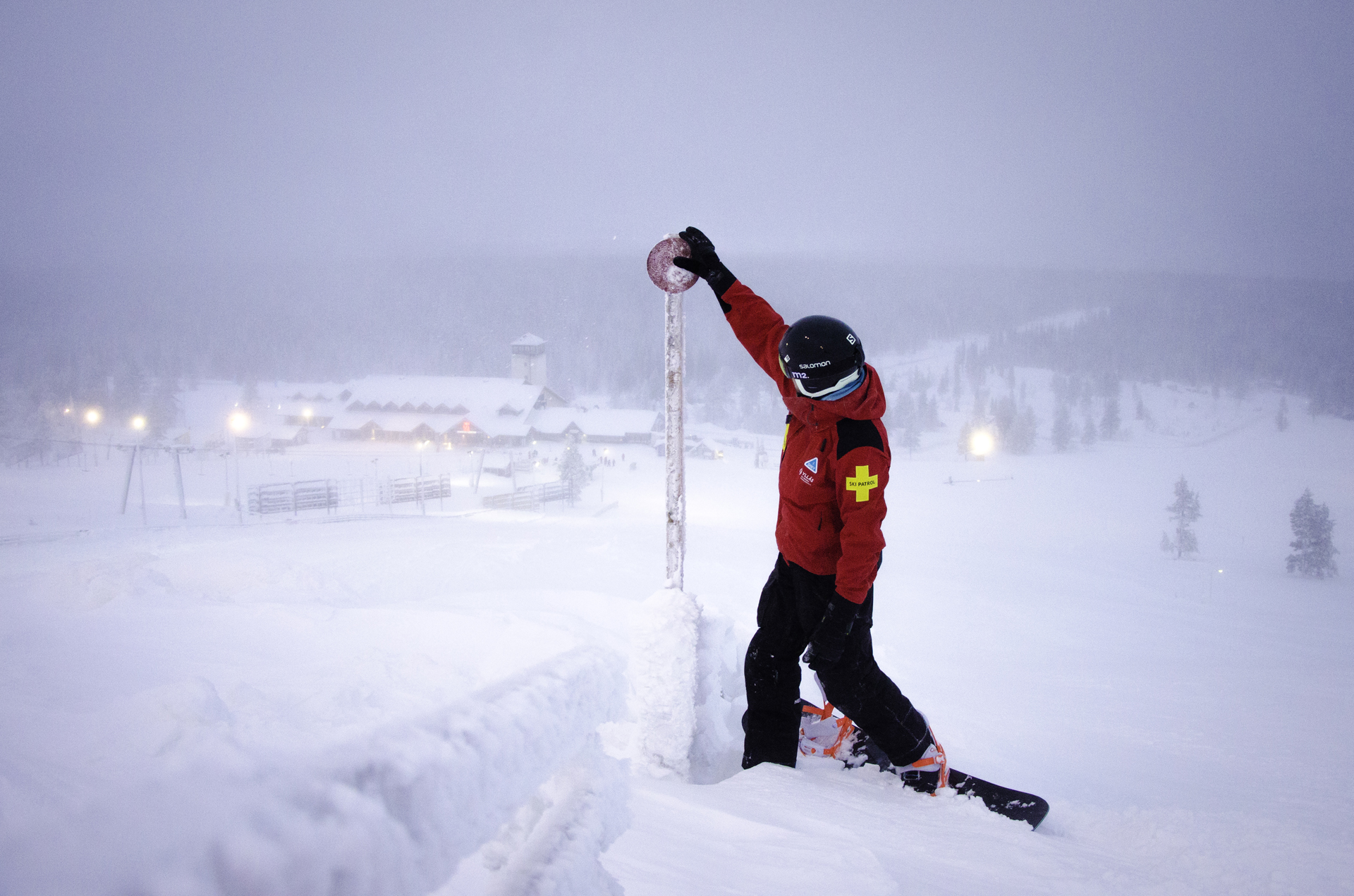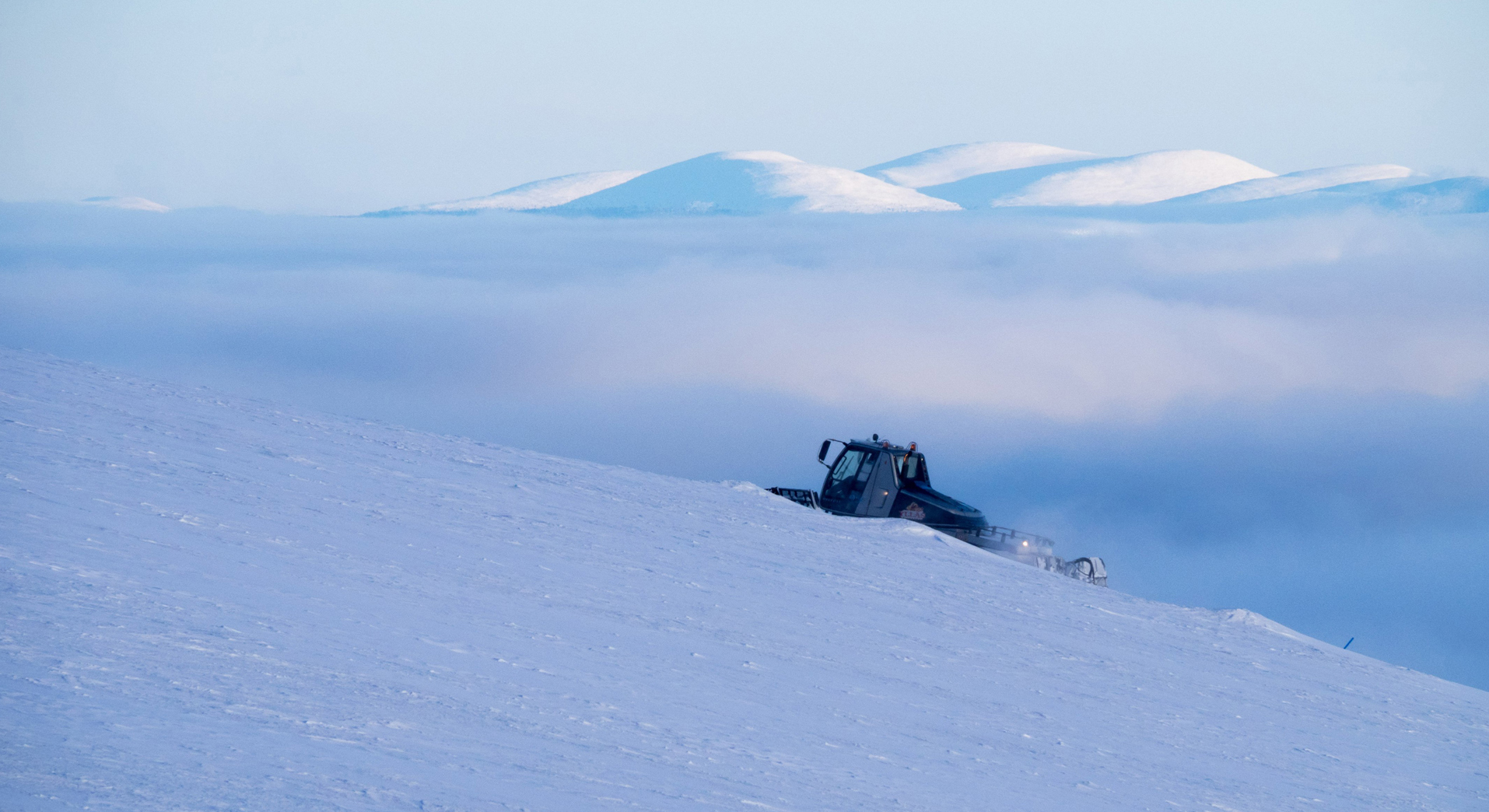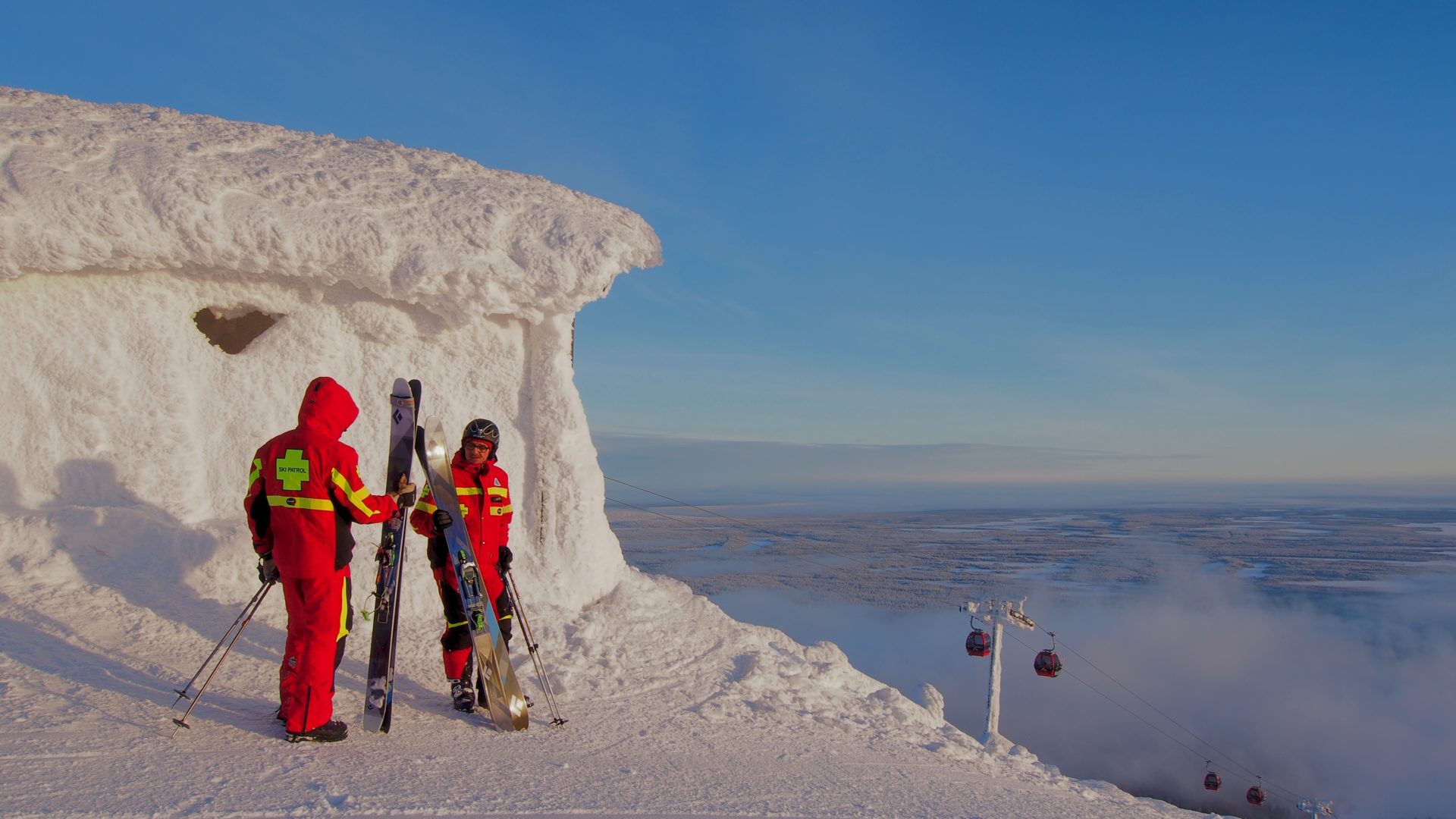Safety is a joint effort
Alpine skiing is a fun, fast-paced activity, and the vast ski resort of Ylläs can have thousands of skiers on peak days. The most extensive piste selection of Finland guarantees that skiers and snowboarders of all skills levels find their favourite and have sufficient space, but in order to ensure a safe day on the slopes for all, everyone must follow the safety rules – just like in traffic.
Ski Patrol Ylläs patrols and instructs
Ylläs is a pioneer in Finnish ski patrol and slope safety, and we have been actively involved in developing a shared patrol training system for the ski resort industry.
Ski patrollers in their red outfits have become a familiar sight in almost all ski resorts in Finland. They specialise in all aspects of slope safety.
They monitor the condition of the slopes and ensure that signposts, border markings and bump rails are in place – in short, they are responsible for the details that make each day on the slopes safe. The patrollers guide and help everyone who needs assistance – and, if needed, intervene if they notice behaviour that compromises the safety of others.
Contact information for visiting Ski Patrols: +358 400 537 602 Mikko Lönnström / Ylläs Ski Resort Äkäslompolo.

Ski lifts
Ylläs has 28 lifts with a total capacity of approximately 30,000 passengers per hour.
The Ylläsjärvi ski resort has a gondola lift, and Äkäslompolo has one four-person chair lift. Most of the other lifts are platter lifts or T-bar lifts.
Ylläs has a total of three carpet lifts, two on the Ylläsjärvi side and one in the children’s training track in Äkäslompolo, which also has the only rope tow in Ylläs.
The carpet lifts and the rope tow are the easiest to use, which makes them particularly well suited for small children.
Platter lifts take skiers up the hill one-by-one at a slow pace. Getting on the lift is easy, which makes this lift type suitable for children and beginners.
T-bars are designed for two people and, because the pace of T-bar lifts is usually a bit faster, riding a T-bar might take some practice for children and novice adults. The lift personnel will help and guide you. We recommend that children practise using the T-bar first at the ski school or with an experienced adult.
Carrying a child in a baby carrier in a skilift and downhill skiing is not allowed due the safety reasons.
Slope maintenance
The slopes are maintained by a snow groomer every day after the lifts close. The grooming takes place immediately in the evening, during the night or in the early morning. The exact maintenance time depends on the conditions and the following day’s weather forecast. The aim is to optimise the condition of the slopes for the next day.
However, snowfalls or the wind can add new snow on previously maintained slopes before the lifts open or later during the day. When this happens, we might need to temporarily close down some lifts to groom the lift tracks again. It would not be safe or sensible to groom the slopes more extensively during the day, which means that skiers and snowboarders should be mindful of exceptional weather conditions.
Slopes marked with a Slope closed sign are temporarily out of use, and riding them might be risky. For example, in the early season, the slope may look safe after a snowfall, although the layer of snow is not thick or firm enough. In this case, skiers entering the forbidden zone might face the unpleasant surprise of bare blockfield amidst the snow.
Warnings and prohibition signs are used for a purpose, and everyone should obey them for their own safety.

Park areas and off-piste slopes
In addition to maintained slopes, Ylläs offers terrain park areas where safety matters are even more important.
Snow parks, ski jumps and ungroomed off-piste slopes require careful advance preparation and a sufficient skill level.
Off-piste slopes are intended for freeriding, and they are not groomed after snowfall like normal slopes. Instead, they remain in their natural state throughout the season. However, the ski patrol monitors the snow situation of off-piste slopes, and the slopes are opened only when the layer of snow is sufficiently thick and firm. Nevertheless, skiers should be prepared for individual rocks on the surface of the snow, cornices, dents and other natural phenomena.
Conditions in the snow parks can also change daily, affecting the glide of the equipment. As a result of this, a safe speed can vary greatly from day to day on each terrain. For this reason, we recommend testing the speed before performing the most challenging tricks.
First aid on the slopes
Both of the ski resorts at Ylläs are extensive with a large number of slopes. For this reason, Äkäslompolo and Ylläsjärvi have their own separate first aid units.
In Äkäslompolo, the first aid personnel of Ski Patrol Ylläs transport the injured safely to the local first aid clinic, and actual first aid is provided by the nurses and – where necessary – doctors of the Medi-Ylläs medical centre.
Ylläsjärvi follows the same procedure, with the exception that the healthcare professionals working at the first aid clinic are employed by the ski resort.
If necessary, the patients are referred to the health centres of nearby municipalities or the Lapland Central Hospital in Rovaniemi for further treatment.
In the case of an emergency, call the emergency telephone number 112.
Slope rules
Follow these simple rules to make the day on the slopes safer for everyone – including yourself.
- Make sure that your equipment works properly and check your bindings. We recommend using a helmet.
- Stay in your place in the lift queue and fill each place in the lift. Leave the lift only in the designated unloading areas.
- Choose slopes that match your skill level. Familiarise yourself with the terrain park areas before using them.
- Pass others on the slope at a sufficient distance. The person coming from behind always has the responsibility to avoid others. Pay particular attention to small children.
- If you must stop, stop at a place where you are noticed. If you are moving up the slope, use the edge of the slope.
(Instructions for skinners.) - Control your speed based on your skills. Observe local slope and snow conditions.
- Sledding is only permitted in designated areas.
- You ski at your own risk. Please note that off-piste accidents outside of maintained slopes might not be covered by regular accident insurance.
- Moving on the slopes intoxicated is prohibited.
- Everyone is required to help in the case of an emergency. Report all emergencies immediately to personnel.
Always follow the signs and the instructions given by the ski resort personnel. The personnel have the right to confiscate the lift ticket of anyone who fails to follow the slope rules.
Park rules
- Familiarise yourself with the terrain park areas before using them.
- Make sure that the landing is clear.
- Only stop in areas where other notice you easily. Do not stay in the landing areas of jumps.
- Choose terrain that matches your skill level.
- Pay attention to the weather.
- If you are approaching from above, it is your responsibility to avoid others.
T-bar lift rules
- Queueing for the lift
Go to the end of the queue and move with the queue. Have your lift ticket at hand well before the gate. Read the lift instructions near the lifts. Ask for advice from the lift operators, if needed. The lift personnel are responsible for guiding the users and for safety. There is a waiting area and/or automatic gate near the lift start point where people place themselves side-by-side to wait for their turn. Move swiftly to the start point and wait for the T-bar standing side-by-side. - Preparations at the lift start point
If you have poles, hold them in your outer hand from the point of view of the lift and place yourself in the designated start point. Grab the T-bar with your free hand and guide the bar behind your body, around your upper thighs or between your legs if you are riding on a snowboard. - Starting the lift ride
Stay calm and wait for the lift to pull you up. Do not sit on the T-bar, simply lean gently on it. Taking a sliding step in the direction you are going helps to get started and makes the pull more subtle. - Safety in the lift
Stand evenly on your skis or snowboard to keep your balance. The height of the T-bar behind your bodies should be based on the shorter partner to ensure optimal balance. - Riding the lift
Do not play in the lift. Playing puts yourself and others in the lift at risk and can even damage the lift. - Preparing for stepping off the lift
Stay on the track, do not make waves or turns. Only leave the lift at the designated unloading area. - Exiting the lift
If you fall, let go of the T-bar immediately and try to move away from the unloading track. It will be difficult for those coming behind you to avoid you if the track is crowded. - Do not stay in the unloading area
The lift track has a signpost approximately 30 metres before the exit point, and the unloading area has signposts that indicate the exit point and direction. Be prepared to exit the lift in advance and ensure that the T-bar does not get stuck on your clothes
Chair lift instructions
- Queueing for the lift
Go to the end of the queue and move with the queue. Have your lift ticket at hand well before the gate. Read the lift instructions near the lifts and pay attention to the lift capacity. Children who are under 125 cm tall may use the chair lift only accompanied by an adult. Ask for advice from the lift operators, if needed. The lift personnel are responsible for guiding the users and for safety. There is a waiting area and/or automatic gate near the lift start point where people place themselves side-by-side to wait for their turn. Move swiftly to the start point and wait for the chair standing side-by-side. - Preparations at the lift start point
If you have ski poles, move them to your other hand and grab the front of the chair with your free hand. Try to sit down at the same time. - Starting the lift ride
After sitting down, wait until the lift sets off. Keep your skis in place, pointing in the same direction during takeoff and pull down the safety rail immediately. - Safety in the lift
Do not move your skis excessively, because if your skis hit each other, your bindings might come off. Hold the safety rail closed throughout the ride and do not swing the chair. No smoking in the lift. - Riding the chair lift
Do not play in the lift. Hold on to your ski poles and avoid handling loose items such as your gloves in the lift. Equipment and clothing that fall from the lift can be permanently lost, because the lift track contains long sections of unbroken snow. - Preparing for stepping off the lift
There is a signpost on the lift track before the exit area. Make sure that your equipment or clothing are not stuck in the structures of the lift. Open the safety rail at the signpost. Keep the tips of your skis or snowboard up. - Exiting the chair lift
Step up from the chair lift at the signpost that indicates the exit point and direction and stand up in front of the chair. Wait for the chair to push you uphill towards the exit area. - Wait for the chair to push you uphill towards the exit area
Move away from the unloading area as soon as possible to make room for those coming behind you. This avoids collision and ensures smooth and safe unloading.
